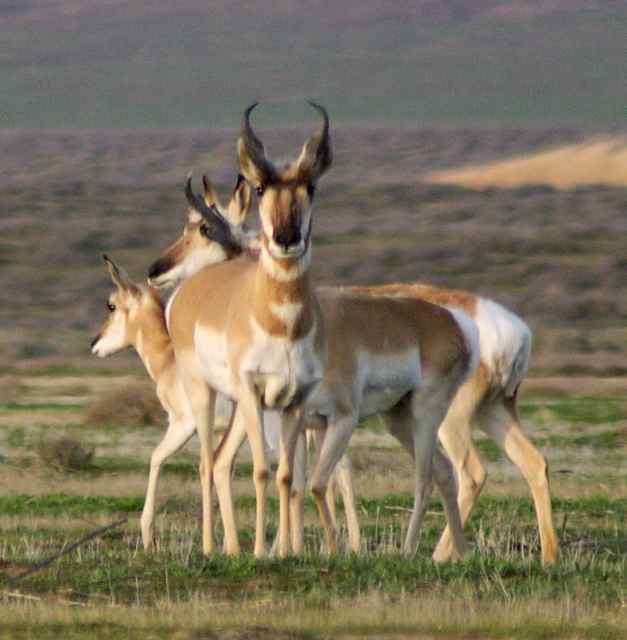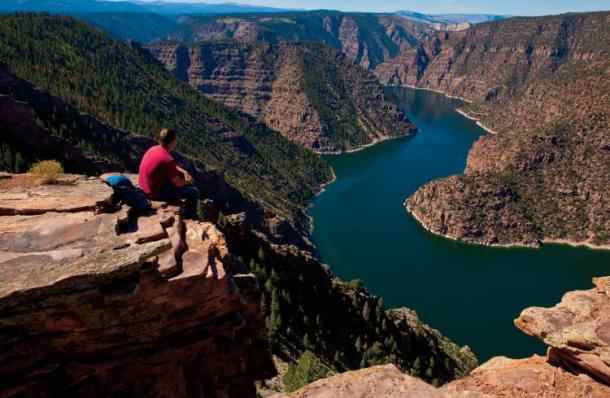RESEARCHERS STUDY WYOMING SOUTHWEST PRONGHORN ANTELOPE HERDS

by Wyoming Game & Fish
11-26-2013
307-777-4600
Website
GREEN RIVER-- Wildlife researchers with the University of Wyoming (UW), the Wyoming Game and Fish Department (WGFD), and the Bureau of Land Management (BLM) are cooperating on a project to study pronghorn antelope in the Bitter Creek, Baggs, and Red Desert Pronghorn antelope herds.
According to biologists, both herds are under increasing pressure from increasing human presence and have seen declines in numbers and the ability to recover from hard winters over the past 20 years, primarily because fawn production is very low. The intent of the study, Factors Influencing Pronghorn Survival and Reproduction in South-Central, Wyoming, is to provide credible information to industry, the WGFD, and land management agencies, such as the BLM, that are involved in permitting energy development in south-central Wyoming. In this study, the Bitter Creek and Baggs pronghorn antelope herds are the study herds, or impact herds, and the Red Desert herd is the control herd because there is little to no impact from roads and industry.
130 adult doe pronghorn antelope were captured from a helicopter the second week of November. Wildlife biologists with Native Range Capture Services used net guns to capture the pronghorn and transport them though the air to a mobile work station where tests were conducted on each pronghorn.
"Each pronghorn was aged, weighed, their blood tested for pregnancy and disease, and their body fat measured," said Baggs Wildlife Biologist Tony Mong. "Fecal samples were collected to determine pronghorn stress levels and each animal was fitted with a collar. The proposal for this three-year study specifies that thirty-five animals in each study area will be fitted with GPS collars, which will record locations across 3 years. Twenty-five additional animals in each study area will be fitted with VHF collars to bolster the sample for survival estimation. The pronghorn will be monitored from the air on a bimonthly basis. All the collars will be retrieved once an animal dies or after the collars are automatically released in August 2015."
Mong said the research project has four objectives: (1) Evaluate and compare pronghorn survival and reproductive output in two areas that contain oil and gas fields and one reference study site in south-central Wyoming, (2) identify areas of crucial pronghorn winter range in south-central Wyoming, (3) evaluate and compare pronghorn behavioral and physiological responses to infrastructure associated with well pads and a site that has received very little gas/oil pressure in south-central Wyoming, and (4) determine if there are fences that may be impeding habitat selection or migration movements within each of three study areas in south-central Wyoming.
"This study will provide an opportunity to better understand the influence of oil and gas fields on the survival and reproduction of pronghorn in south-central Wyoming," Mong said. "The study will provide direct measures of survival, population productivity and resource selection, delineate crucial winter ranges and critical migration corridors, and provide information on fences that may be limiting habitat selection, migration, and winter range."
Mong said there are several people from a variety of academic and community organizations, energy companies, and state and federal agencies that are making this study possible.
"UW Master's student Adele Collier, her co-advisers, UW Wildlife Cooperative Research Professors Dr. Jeffrey L. Beck and Kevin Monteith, volunteers, and BLM and Game and Fish personnel finished the first phase of winter trapping in mid-November," Mong said. "We are very fortunate there is also a long list of financial contributors that include: British Petroleum, Black Diamond LLC, Devon energy, Samson Energy, Warren Resources, Wyoming Reclamation and Restoration Center, UW Office of Academic Affairs, and the Wyoming Governor's Big Game License Coalition."
"We want to learn more about pronghorn ecology and biology through this study," said UW graduate student Adele Collier. "We hope to learn more about how pronghorn are affected by environmental limiting factors and human-caused impacts."
"We will be working hard over the next three years to effectively coordinate every phase of the research project," Mong said. "All information collected and analyzed for this pronghorn antelope study will provide industry better information as development is planned and will allow BLM and WGFD to make better decisions on mitigation measures for future development of both the Wamsutter and Atlantic Rim oil and gas fields."
According to biologists, both herds are under increasing pressure from increasing human presence and have seen declines in numbers and the ability to recover from hard winters over the past 20 years, primarily because fawn production is very low. The intent of the study, Factors Influencing Pronghorn Survival and Reproduction in South-Central, Wyoming, is to provide credible information to industry, the WGFD, and land management agencies, such as the BLM, that are involved in permitting energy development in south-central Wyoming. In this study, the Bitter Creek and Baggs pronghorn antelope herds are the study herds, or impact herds, and the Red Desert herd is the control herd because there is little to no impact from roads and industry.
130 adult doe pronghorn antelope were captured from a helicopter the second week of November. Wildlife biologists with Native Range Capture Services used net guns to capture the pronghorn and transport them though the air to a mobile work station where tests were conducted on each pronghorn.
"Each pronghorn was aged, weighed, their blood tested for pregnancy and disease, and their body fat measured," said Baggs Wildlife Biologist Tony Mong. "Fecal samples were collected to determine pronghorn stress levels and each animal was fitted with a collar. The proposal for this three-year study specifies that thirty-five animals in each study area will be fitted with GPS collars, which will record locations across 3 years. Twenty-five additional animals in each study area will be fitted with VHF collars to bolster the sample for survival estimation. The pronghorn will be monitored from the air on a bimonthly basis. All the collars will be retrieved once an animal dies or after the collars are automatically released in August 2015."
Mong said the research project has four objectives: (1) Evaluate and compare pronghorn survival and reproductive output in two areas that contain oil and gas fields and one reference study site in south-central Wyoming, (2) identify areas of crucial pronghorn winter range in south-central Wyoming, (3) evaluate and compare pronghorn behavioral and physiological responses to infrastructure associated with well pads and a site that has received very little gas/oil pressure in south-central Wyoming, and (4) determine if there are fences that may be impeding habitat selection or migration movements within each of three study areas in south-central Wyoming.
"This study will provide an opportunity to better understand the influence of oil and gas fields on the survival and reproduction of pronghorn in south-central Wyoming," Mong said. "The study will provide direct measures of survival, population productivity and resource selection, delineate crucial winter ranges and critical migration corridors, and provide information on fences that may be limiting habitat selection, migration, and winter range."
Mong said there are several people from a variety of academic and community organizations, energy companies, and state and federal agencies that are making this study possible.
"UW Master's student Adele Collier, her co-advisers, UW Wildlife Cooperative Research Professors Dr. Jeffrey L. Beck and Kevin Monteith, volunteers, and BLM and Game and Fish personnel finished the first phase of winter trapping in mid-November," Mong said. "We are very fortunate there is also a long list of financial contributors that include: British Petroleum, Black Diamond LLC, Devon energy, Samson Energy, Warren Resources, Wyoming Reclamation and Restoration Center, UW Office of Academic Affairs, and the Wyoming Governor's Big Game License Coalition."
"We want to learn more about pronghorn ecology and biology through this study," said UW graduate student Adele Collier. "We hope to learn more about how pronghorn are affected by environmental limiting factors and human-caused impacts."
"We will be working hard over the next three years to effectively coordinate every phase of the research project," Mong said. "All information collected and analyzed for this pronghorn antelope study will provide industry better information as development is planned and will allow BLM and WGFD to make better decisions on mitigation measures for future development of both the Wamsutter and Atlantic Rim oil and gas fields."
< Previous Report Next Report >
< Previous Report
Next Report >

11-26-2013
GREEN RIVER-- The Wyoming Game and Fish Department is holding public meetings to discuss Chapter 3 - Black Bear Hunting...... Read More

: Information Gathering Meeting On Wyoming Hunting Seasons
: Volunteers and Green River High School Students Assist with Fontenelle Fish Netting
Flaming Gorge Reservoir (UT & WY): Anglers West TV fishes Kokanee at Flaming Gorge
More Reports

11-26-2013
GREEN RIVER-- The Wyoming Game and Fish Department is holding public meetings to discuss Chapter 3 - Black Bear Hunting...... Read More
Wyoming Game & Fish Department Reports
for Monday, November 25th, 2013
: Information Gathering Meeting On Wyoming Hunting Seasons
: Volunteers and Green River High School Students Assist with Fontenelle Fish Netting
Flaming Gorge Reservoir (UT & WY): Anglers West TV fishes Kokanee at Flaming Gorge
000

